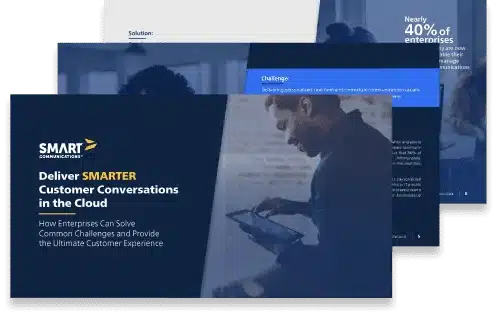Unlocking Digital Inclusion: Embracing Global Accessibility Awareness
By Chris Murphy, VP of Product Marketing at Smart Communications
One billion people. That’s three times the population of the United States—and the number of people around the world who are reported to have a disability or impairment. Imagine a world where every individual, regardless of their circumstances, can seamlessly navigate the digital realm. May 16, 2024 is the 13th Global Accessibility Awareness Day (GAAD) which shines a light on the importance of making our digital world a place where everyone feels empowered and valued. Most importantly, it encourages companies to think holistically about improving digital access and offering digital services in a more inclusive way.
The need for digitally accessible solutions and services isn't just about meeting regulations; it's about creating a more inclusive and vibrant digital landscape. When individuals face barriers online, it not only affects their ability to interact with businesses but also hampers the valuable contributions employees can make to their organizations. However, this growing awareness of digital accessibility sheds light on the shift in compliance and gives due recognition to the importance of ensuring equal access and engagement for all individuals in the digital sphere.
According to the GAAD (Global Accessibility Awareness Day) Foundation, here are where most digital experiences fall short:
Source: https://accessibility.day
Drivers for Digital Accessibility Interest
There are several key drivers pushing organizations to evaluate their accessibility and build accessibly-oriented business practices, guidelines, and compliance frameworks. Those are:
1. Compliance: Accessibility rules and regulations can vary broadly from region to region (for example, the Americans with Disabilities Act, the EU Accessibility Act, the Accessible Canada Act), but it is fair to say that there is a growing trend in both the number and strictness of the legislative oversight—as well as the number of lawsuits and value of fines for noncompliance.
2. Customer Experience: Organizations have also focused on accessibility initiatives to help provide better experiences for their consumers and to serve a broader pool of their target market more effectively.
3. Employee Experience: According to IDC’s Digital Accessibility Survey from September 2022, providing a better user experience to internal employees was one of the main reasons to implement digital accessibility - more than customer experience, business benefit, and corporate value reasons.
Who Benefits from Digital Accessibility Initiatives?
The short answer: more than you think. Digital accessibility guidelines and regulations have primarily been put in place to protect the pockets of individuals impacted by a disability or impairment. It's easy to imagine how someone with a visual limitation—complete or partial blindness, for example—might struggle with digital experiences. Those with visual impairments often benefit from improvements around color/text contrast ratios, the ability to zoom without loss of clarity, and the ability to utilize common technologies like screen readers that can translate these digital interactions into auditory experiences. Alternatively, individuals with auditory impairments typically benefit from captions or descriptions discerned from screen readers and visual media transcripts.
Good accessibility practices benefit everyone. Being able to zoom in on a document or see text with a good contrast ratio creates a more inclusive experience for people with declining eyesight as well as for those who are partially blind/visually impaired. Communications written in plain, understandable language—that avoid using jargon or slang—can help individuals with cognitive impairments as well as those where English (or the communication language) may not be their first language or who read at a lower-than-average reading level.-
How Software Vendors Can Help With Your Digital Accessibility Frameworks
Increasingly, leading organizations are leaning on their software value-chain partners and vendors for support with their accessibility initiatives—with Customer Communications Management (CCM) and form process automation solutions being a major part of their accessibility strategy. There are several areas in which this is happening;
-
Accessible Customer Communications: Leading CCM solutions are able to help organizations create and manage accessible experiences for their customers. Some examples include accessible PDFs, and communications that can be effectively read by a screen reader. Communications can also be exported in XML format that can then be ingested into third-party solutions for transformation to Braille, Large Print, and other formats that may be required.
-
Accessible Customer Form Experiences: Much like standard customer communications, digital forms need to offer a range of tools that can offset a consumer's physical disabilities or impairments. The ability to include images with alternative text or build a question sequence that guides the experience (and avoids ever having to reference a specific place within a form) are “small” but significant steps toward creating accessible data collection processes. Taking it one step further, companies can compensate for various reading levels by including helper text to offer clarification and data validation messages to help the end-user feel confident that what they are providing is correct and will take them to the next desired step in the process.
-
Accessible Software and UI Experiences: While improving the customer experience and being able to serve a more diverse and broadened customer base through improved accessibility remain important drivers, enhancing the employee experience is also a key motivator for accessibility projects. Ensuring the software and solutions employees utilize everyday meet accessibility standards is becoming a prerequisite for procurement and commercial teams. Accessible software solutions offer features that maximize the number of individuals who can use them effectively. Common requirements include keyboard shortcuts, keyboard focus, semantic ordering of content, standardized tab order to navigate to different sections of the user interface, ARIA role attributes, appropriate contrast ratios and other functions that are important in promoting inclusivity.
When considering a new software vendor, leading organizations will be able to provide you with a Voluntary Product Accessibility Template (or VPAT for short). This type of document is often administered by a third-party accessibility firm and identifies areas of the software under consideration that either comply with or are out of conformance with specific accessibility standards.
Additional questions around the development strategy and testing regime for new functionality or applications within the software will help you understand how well a vendor's R&D team is operationalizing accessibility for the future.
Conclusion
By prioritizing accessibility in our digital designs, communications, and interactions, we not only meet legal requirements but also unlock the potential for innovation, creativity, and empathy.
Through our dedicated efforts and ongoing initiatives, we at Smart Communications strive to lead by example, ensuring that our digital solutions prioritize inclusivity and empower individuals of all abilities to fully engage with the digital world. We’re proud of our track record in assisting our customers in producing accessible communications and forms experiences, and we remain committed to our dedicated roadmap of innovative enhancements. These efforts not only position our customers as leaders in compliance but also elevate their customer and employee experiences, ensuring inclusivity and empowerment for individuals of all abilities.
Let us continue to champion accessibility not just today, but every day, as we strive to create a world where barriers are replaced with bridges, and inclusion becomes the norm.



